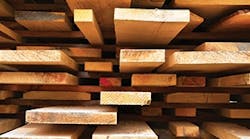When you think of sustainable products, does transportation distance, materials origin, or manufacturing site come to mind?
Beyond recycled content and green certifications, locally sourced products can also boost your sustainability credibility.
Regional materials are produced within a certain distance from your project site. Definitions vary between certification programs, but they often use a range of miles to qualify products.
LEED, the most common standard used, defines regional materials in MR Credit 5 as “building materials or products that have been extracted, harvested, or recovered, as well as manufactured, within 500 miles of the project site for a minimum of 10% or 20%, based on cost, of the total materials value.”
This radius typically includes several neighboring states and provides a wealth of eligible products. Read on to learn how to enhance your building project with regional materials.
Key Advantages
When specifying regional products, look at raw materials that represent the most weight and greatest transportation cost, such as brick, cement, steel, glass, wood, and sheetrock, says Patrick Nye, a senior consultant for the Bonneville Environmental Foundation.
Far too often, green products are defined by individual characteristics such as VOC levels or recyclability. By specifying regional materials, however, a product’s sustainability profile will extend to extraction, manufacturing, and transportation practices.
Consider how far a product must travel between its point of origin, the manufacturing site, and your building site. Each step of the journey burns transportation fuel. If you cut down on the travel distance, however, a product’s environmental impact is greatly lessened.
“This creates a much smaller carbon footprint for the materials,” explains Nye, “reducing what could be thousands of miles worth of greenhouse gas emissions related to product transport.” PageBreak
How to Get Started
No matter the scale of your building project, ask your design team to include local materials from the onset. Because regional procurement may limit some of your options, you need the flexibility to adapt plans to fit what’s available locally. This will be easier to adjust during the design stage than after ground is broken, says Nye.
“You also want to leave team members with enough time to research qualified materials, secure competitive bidding, and examine how selected products will impact the overall project costs,” adds Zach Bergeron, purchasing manager and green team captain for Suffolk Construction.
In most cases, your design team will be responsible for securing documentation of a product’s origin. Owners, however, should voice any specific requirements to the design team. Is 500 miles a suitable radius or should it be 250? Is it important that some materials originate within your specific state or even city?
Because regional materials can be a green calling card for a business, you may want to display these products in an eye-catching way. No one may know that your drywall was sourced within 100 miles, but the wood paneling in your lobby or cabinets in a break room may be an opportunity to showcase regional products to clients and employees.
Keep in mind that not all definitions of “regionally produced” are equal. Some may require that materials are harvested within the same area as the manufacturing site, while others allow for raw materials to be imported from elsewhere.
“Building owners should be clear and comfortable with the definition of regionally produced they choose to follow,” says Nye. “This should also be clear in any public claims made touting local procurement.”
Limitations to Consider
Because you are working with fewer suppliers, you may face less price competition when using regional materials, says Bergeron. This could result in a slight cost premium for a local product.
Material availability is another consideration. Depending on your location, limestone from Indiana or steel from Pittsburgh may not be an option. Your project requirements may also present limitations.
“Some developers, like institutions, need a building that lasts 100 years, not 25 to 50,” notes Bergeron. “Depending on the goals of a design, sometimes those materials can be sourced locally and sometimes they simply cannot.”
Remember that regional materials are only a certain percentage of your total project. You may find that 100% of your wood products can be sourced locally, allowing you to specify your glass from anywhere in the country. Maybe 25% of your concrete needs can be satisfied regionally, but the rest must come from further away. It’s all a matter of balance.
“Ask yourself if you can get the materials at the cost, volume, and within the timing to satisfy your project requirements. There is value in using regional materials, just as there is with products sourced elsewhere,” Bergeron says. “It all comes down to what will make for a better building.”
Jennie Morton [email protected] is associate editor for BUILDINGS.


